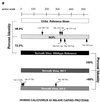Systemic, mucosal, and heterotypic immune induction in mice inoculated with Venezuelan equine encephalitis replicons expressing Norwalk virus-like particles
- PMID: 11752163
- PMCID: PMC136807
- DOI: 10.1128/jvi.76.2.730-742.2002
Systemic, mucosal, and heterotypic immune induction in mice inoculated with Venezuelan equine encephalitis replicons expressing Norwalk virus-like particles
Abstract
Norwalk-like viruses (NLVs) are a diverse group of single-stranded, nonenveloped, positive-polarity RNA viruses and are the leading cause of epidemic acute gastroenteritis in the United States. In this study, the major capsid gene of Norwalk virus, the prototype NLV, has been cloned and expressed in mammalian cells using a Venezuelan equine encephalitis (VEE) replicon expression system. Upon infection of baby hamster kidney (BHK) cells with VEE replicon particles (VRPs), the Norwalk virus capsid proteins self-assemble to generate high titers of Norwalk virus-like particles (VLPs) that are morphologically and antigenically analogous to wild-type Norwalk virus. Mice inoculated subcutaneously with VRPs expressing the Norwalk virus capsid protein (VRP-NV1) developed systemic and mucosal immune responses to Norwalk VLPs, as well as heterotypic antibody responses to the major capsid protein from another genogroup I NLV strain (NCFL) isolated from a recent outbreak. A second Norwalk virus capsid clone (NV2) containing three amino acid codon mutations from the NV1 clone was also expressed using VEE replicons (VRP-NV2), but upon infection of BHK cells failed to confer VLP self-assembly. Mice inoculated with VRP-NV2 elicited reduced systemic and mucosal immune responses to Norwalk VLPs, demonstrating the importance and potential utility of endogenous VLP presentation for maximum immune induction. Inoculation with either VRP-NV1 or VRP-NV2 resulted in serum antibody responses far superior to the induction in mice dosed orally with VLPs that were prepared using the VEE-NV1 replicon construct, a regimen similar to current models for NLV vaccination. Expression of NLV VLPs in mammalian cells offers a powerful approach for the design of novel NLV vaccines, either alone or in combination with current vaccination models.
Figures







Similar articles
-
Replicon-helper systems from attenuated Venezuelan equine encephalitis virus: expression of heterologous genes in vitro and immunization against heterologous pathogens in vivo.Virology. 1997 Dec 22;239(2):389-401. doi: 10.1006/viro.1997.8878. Virology. 1997. PMID: 9434729
-
Expression and self-assembly of norwalk virus capsid protein from venezuelan equine encephalitis virus replicons.J Virol. 2002 Mar;76(6):3023-30. doi: 10.1128/jvi.76.6.3023-3030.2002. J Virol. 2002. PMID: 11861868 Free PMC article.
-
Multivalent norovirus vaccines induce strong mucosal and systemic blocking antibodies against multiple strains.Vaccine. 2006 Jun 12;24(24):5220-34. doi: 10.1016/j.vaccine.2006.03.080. Epub 2006 Apr 18. Vaccine. 2006. PMID: 16650512
-
Alphavirus replicon particles as candidate HIV vaccines.IUBMB Life. 2002 Apr-May;53(4-5):209-11. doi: 10.1080/15216540212657. IUBMB Life. 2002. PMID: 12120997 Review.
-
Norwalk virus-like particles as vaccines.Expert Rev Vaccines. 2010 Mar;9(3):299-307. doi: 10.1586/erv.09.163. Expert Rev Vaccines. 2010. PMID: 20218858 Free PMC article. Review.
Cited by
-
Venezuelan equine encephalitis virus replicon particles encoding respiratory syncytial virus surface glycoproteins induce protective mucosal responses in mice and cotton rats.J Virol. 2007 Dec;81(24):13710-22. doi: 10.1128/JVI.01351-07. Epub 2007 Oct 10. J Virol. 2007. PMID: 17928349 Free PMC article.
-
Severe acute respiratory syndrome coronavirus group-specific open reading frames encode nonessential functions for replication in cell cultures and mice.J Virol. 2005 Dec;79(23):14909-22. doi: 10.1128/JVI.79.23.14909-14922.2005. J Virol. 2005. PMID: 16282490 Free PMC article.
-
Nonmucosal alphavirus vaccination stimulates a mucosal inductive environment in the peripheral draining lymph node.J Immunol. 2008 Jul 1;181(1):574-85. doi: 10.4049/jimmunol.181.1.574. J Immunol. 2008. PMID: 18566424 Free PMC article.
-
Recombinant vectors as influenza vaccines.Curr Top Microbiol Immunol. 2009;333:243-67. doi: 10.1007/978-3-540-92165-3_13. Curr Top Microbiol Immunol. 2009. PMID: 19768410 Free PMC article. Review.
-
Norovirus vaccines and potential antinorovirus drugs: recent advances and future perspectives.Future Virol. 2015;10(7):899-913. doi: 10.2217/fvl.15.57. Future Virol. 2015. PMID: 26568768 Free PMC article.
References
-
- Arness, M. K., B. H. Feighner, M. L. Canham, D. N. Taylor, S. S. Monroe, T. J. Cieslak, E. L. Hoedebecke, C. S. Polyak, J. C. Cuthie, R. L. Fankhauser, C. D. Humphrey, T. L. Barker, C. D. Jenkins, and D. R. Skillman. 2000. Norwalk-like viral gastroenteritis outbreak in U.S. Army trainees. Emerg. Infect. Dis. 6:204–207. - PMC - PubMed
-
- Ball, J. M., D. Y. Graham, A. R. Opekun, M. A. Gilger, R. A. Guerrero, and M. K. Estes. 1999. Recombinant Norwalk virus-like particles given orally to volunteers: phase I study. Gastroenterology 117:40–48. - PubMed
-
- Becker, K. M., C. L. Moe, K. L. Southwick, and J. N. MacCormack. 2000. Transmission of Norwalk virus during a football game. N. Engl. J. Med. 343:1223–1227. - PubMed
-
- Bernard, K. A., W. B. Klimstra, and R. E. Johnston. 2000. Mutations in the E2 glycoprotein of Venezuelan equine encephalitis virus confer heparan sulfate interaction, low morbidity, and rapid clearance from blood of mice. Virology 276:93–103. - PubMed
Publication types
MeSH terms
Substances
Grants and funding
LinkOut - more resources
Full Text Sources
Other Literature Sources
Medical

